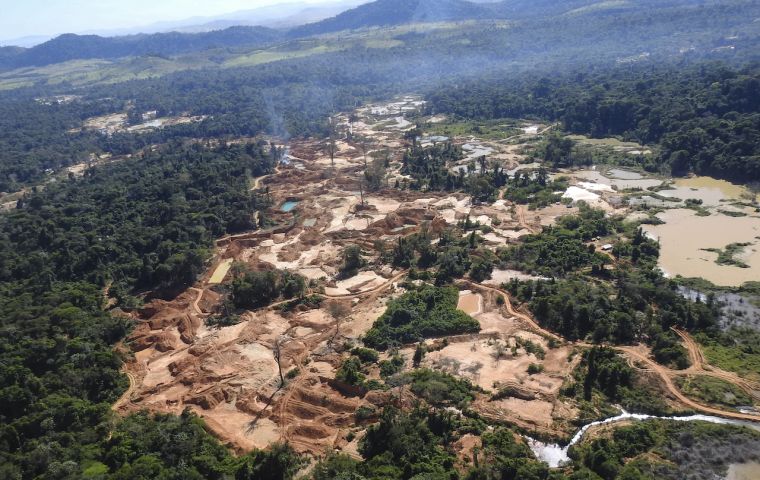MercoPress. South Atlantic News Agency
Research shows illegal mining in Brazil on the rise
 Garimpo is spreading at an unprecedented pace
Garimpo is spreading at an unprecedented pace A scientific report released Monday by the organization MapBiomas showed that 65% of mining activities carried out in the Brazilian Amazon basin were not legal.
MapBiomas also reported illegal mining in Brazil had grown 495% between 2010 and 2020.
Garimpo is the technical word in Portuguese for artisanal mining and the labourers who performed it are known as garimpeiros. The activity has increased fivefold in indigenous lands and 301%in conservation areas, according to MapBiomas.
The study also pointed out that mining had spread to a surface of 6,500 hectares per year in the decade between 2010 and 2020, while between 1985 and 2009, the average annual use was 1,500 hectares.
The MapBiomas report also underscored that more than 72% of the extraction areas nationwide were in Amazonian lands and of all of the mining in the largest jungle on the planet, 67.6 % was illegal.
Garimpo is said to be one of the main causes of deforestation. Another adverse consequence of this practice is the contamination of river basins with chemicals.
According to this report, 97.3% of all illegal mining in Brazil occurs in what is considered the world's plant lung, a region that also accounts for almost half (49.2%) of (legal) industrial extractivist activity.
The MapBiomas data stemmed from satellite images and artificial intelligence, which were to study the evolution of mining in Brazil between 1985 and 2020.
This multidisciplinary initiative, in which several NGOs, universities and technology companies participate, revealed that during those 36 years the area occupied by mining in Brazil grew more than six times, jumping from 31,000 hectares in 1985 to 206,000 hectares in 2020.
In environmental reserves, the area occupied by garimpo grew by 301% between 2010 and 2020, while in that decade the advance of illegal mining in indigenous territories was 495%, mainly affecting the lands of the Kayapó, Munduruku and Yanomami ethnic groups, all of them in the Amazon region.
In addition to being concentrated in the Amazon, illegal mining has had a strong expansion in the last decade, with its “maximum record” in just five years (2017 to 2020), a fact that has weighed the gold rush and the high prices that the precious metal has reached in recent years.
The area used by garimpo last year exceeded by almost 10% the area associated with industrial mining (107,800 hectares against 98,300 hectares, respectively).
While the expansion of industrial mining occurred gradually and continuously between 1985 and 2020 - at a rate of about 2,200 hectares each year - the garimpo the situation was different.
Between 1985 and 2009 the growth rate of illegal mining was low - about 1,500 hectares per year - but as of 2010, the expansion rate quadrupled to 6,500 hectares per year, a growth that coincides with the advance of garimpo in conservation areas of the Amazon.
“When we cross-referenced the information on the area under mining exploitation in Brazil with indigenous reserves and conservation units [national parks, etc ...], we were surprised by the amount of mining in prohibited areas,” explained Professor Pedro Walfir, from the University Federal do Pará, one of the coordinators of the report.
According to MapBiomas, 40.7% of the area destined to garimpo, most of which is illegal, is in conservation units, while 9.3% is on indigenous lands, where it is completely illegal.
Eight of the ten conservation areas most affected by garimpo, the vast majority of which are gold, are also in Pará. Garimpeiros often use mercury to separate the particles from the gold, causing great pollution in the rivers.
These data on illegal mining are a new example of the acceleration of environmental deterioration in Brazil since the arrival to power of President Jair Bolsonaro, especially concerning the advance of deforestation and forest fires. The president, favourable to the opening of the jungle to agricultural and mining activities, and his agribusiness allies in Congress are accelerating the processing of projects seen by indigenous people and environmentalists as threats to ancestral lands and protected areas. One of them, proposed by the government, seeks to authorize the authorization of mining and other extractive activities in indigenous reserves.
Last week, thousands of indigenous people, camped out in Brasilia to protest Bolsonaro's “anti-indigenous agenda”, marched towards the Supreme Federal Court (STF), which is analyzing a key case regarding the rights to their ancestral lands.
The so-called “trial of the century” regarding the right of indigenous people to occupy and preserve their ancestral lands, which was assured to them in the Brazilian Constitution of 1988, will be resumed later this week.




Top Comments
Disclaimer & comment rulesCommenting for this story is now closed.
If you have a Facebook account, become a fan and comment on our Facebook Page!